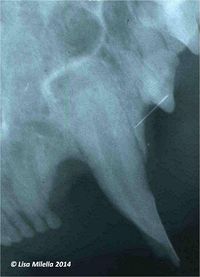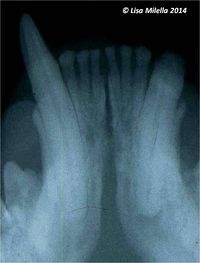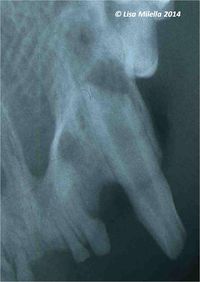Radiographic Interpretation of Endodontic Disease - Small Animal
Interpreting Endodontic Disease
Radiographs may provide information about the presence, nature, and severity of periapical and root pathology. This information is essential for the diagnosis of endodontic disease as well as for the prognosis of its treatment. Radiographs do not provide direct information about pulp health; however, many of the effects of pulp pathology are radiographically visible.
Clinical findings that may indicate the presence of endodontic disease include a fractured tooth with exposure of the pulp chamber, a discolored tooth, or an intraoral or extraoral draining fistula. Except in the obvious case of a direct pulp exposure, a definitive diagnosis of endodontic pathology is difficult to make based only on clinical examination of veterinary patients due to the limitations of pulp testing and lack of patient input.
Radiographs should be made of teeth that are fractured, close to a draining fistula, intrinsically discolored, anomalous, or compromised from periodontal disease to determine the extent of the problem and to evaluate the endodontic and periradicular health.
Dental radiographs can be misleading and unreliable. Early endodontic disease may not show any radiographic abnormalities, while superimposed anatomy can mimic endodontic disease on a radiograph of a healthy tooth. Despite these limitations, dental radiographs continue to be the best tool available to evaluate endodontic health in veterinary patients. The site of exit does not always directly correlate to the problem tooth. Radiographs are needed to determine which tooth is involved.
Radiographic Signs of Endodontic Disease
Inflammation caused by endodontic disease affects the surrounding bone and teeth, resulting in changes that can be radiographically detected. Radiographs that are meant to evaluate the periapical tissues should include the entire root tip and surrounding bone, be well positioned to avoid elongation, foreshortening, angulation, or distortion of the image.
Radiographic signs of endodontic disease that are associated with the tissues around tooth roots include:
- Increased width of the apical radiolucent periodontal ligament space.
- Loss of the radiopaque lamina dura at the apex or other portals of exit such as lateral canals.
- Diffuse periapical radiolucency with indistinct borders that may indicate an acute abscess.
- Clearly evident periapical radiolucency with distinct borders that is evidence of a more chronic lesion.
- Diffuse area of radiopacity where low-grade chronic inflammation results in sclerosing osteitis.
- Changes in the trabecular bone pattern around the root apex.
Radiographic signs of endodontic disease that are associated with the tooth itself include:
- Root tip resorption.
- Internal root or crown resorption. Inflammation of the pulp can cause internal resorption.
- External root resorption. Inflammation in the periodontal ligament can cause external root resorption.
- Arrested tooth maturation (pulp necrosis). Pulp necrosis causes the opposite effect, arresting any further dentin formation or tooth maturation. The result is a tooth that appears radiographically less mature (wider root canal space) than the adjacent teeth.
- Accelerated apparent tooth maturation (pulpitis). Pulpitis can also result in formation of tertiary, or reparative dentin on the walls of the pulp cavity. Pulpitis that is generalized over a section of a root canal creates the radiographic effect of a narrower canal in that section, giving the appearance of a more mature tooth. The extreme of this can manifest as “pulp cavity obliteration,” a radiographic term that describes an inability to identify sections of, or the entire, pulp space.
Endodontic lesions in cats appear radiographically similar to those in dogs.
Lucencies That Can Mimic Endodontic Lesions
Apical radiographs can be challenging to interpret due to the two-dimensional depiction of complicated anatomy that combines trabecular (spongy) bone, compact bone, soft tissue, and air spaces all projected at various angles and configurations. Other confusing lucencies and opacities can be created by the summation effect of superimposed structures, projecting overlying anatomy in a way that makes it appear to be associated with a tooth root or its supporting bone. These can include bony foraminae, bony fissures, bony canals, and trabeculae. Many non-pathological lucencies, opacities, and apparent deviations from normal can be distinguished from true lesions by comparison with a radiograph of the contralateral tooth.
| Radiographic Interpretation of Endodontic Disease - Small Animal Learning Resources | |
|---|---|
To reach the Vetstream content, please select |
Canis, Felis, Lapis or Equis |
| This article was written by Lisa Milella BVSc DipEVDC MRCVS. Date reviewed: 14 August 2014 |
| Endorsed by WALTHAM®, a leading authority in companion animal nutrition and wellbeing for over 50 years and the science institute for Mars Petcare. |
Error in widget FBRecommend: unable to write file /var/www/wikivet.net/extensions/Widgets/compiled_templates/wrt69537e4928d985_44965137 Error in widget google+: unable to write file /var/www/wikivet.net/extensions/Widgets/compiled_templates/wrt69537e49346440_46016359 Error in widget TwitterTweet: unable to write file /var/www/wikivet.net/extensions/Widgets/compiled_templates/wrt69537e49407de9_71743629
|
| WikiVet® Introduction - Help WikiVet - Report a Problem |


